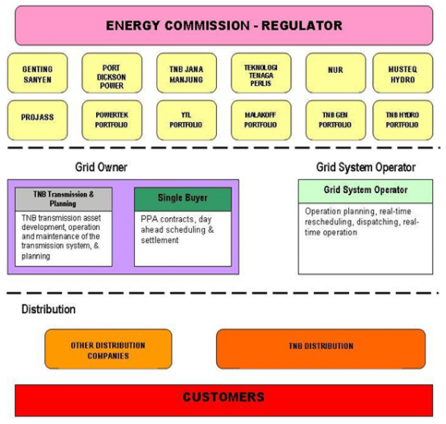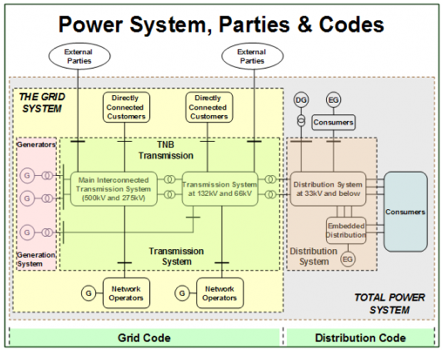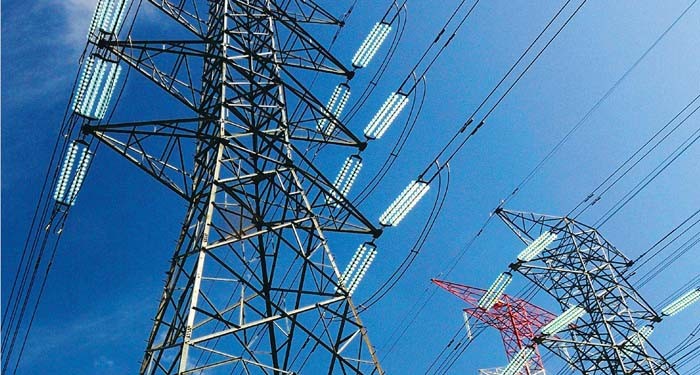The Grid Code and Distribution Code, launched and published by the Energy Commission Malaysia on 21 Dec 2010, is a regulatory instrument used to coordinate various electricity supply activities of the electricity producer, operator, distributor and the consumer. The former is a technical specification which defines the parameters an electricity generating plant and grid system network have to meet to ensure proper functioning of the electrical grid, whereas the Distribution Code is a set of technical regulation established to make certain the operations at the distribution level are being carried out systematically.
The following shows the structure of the Power System, connected Parties and applicable codes:

The Grid Code is a set of technical regulations used by utility companies such as Tenaga Nasional Berhad (TNB) and Independent Power Producers (IPPs) in the Peninsular Malaysia that serves as the main guidelines in electricity supply operation; to ensure the electricity supply in Peninsular Malaysia remains reliable.
The following figure illustrates the Peninsular Malaysia electricity industry structure in terms of functions as used in the Grid Code.

The Distribution Code is a set of technical regulation established to make certain the operations at the distribution level are being carried out systematically.
The Codes will set the regulations and technical requirements that need to be carried out by all party involved in the planning, managing and maintaining the grid and distribution systems to ensure security, safety and reliability at all time.
The following shows the structure of the Power System, connected Parties and applicable codes:

The Codes highlight in details the roles and responsibilities of parties involved in managing or using the system, either through connecting or connected directly to the grid and distribution systems including generators, grid system operators, distribution system operators, single buyer and large power consumers.
The Energy Commission Malaysia as the regulatory body of the energy industry, will chair the committee with members from the industry. It has been enforced since 1 January 2011.
Click here to download the Malaysian Grid Code
The Grid Code is divided into the following parts:
Part I:
Glossary and Definitions: Contains definitions of some terms used in the Grid Code to ensure clarity to the meaning and intention of those terms
Part II:
Introduction and Purpose: Provides a general introduction to the Grid Code, its purpose and general requirements
Part III:
General Conditions: Deals with all administrative aspects of the Grid Code, provisions for the revision of the Grid Code as well as resolution of disputes and procedures associated with derogations and exemptions
Part IV:
Planning Code: Describes the process by which the Grid Owner undertakes the planning and development of the Grid System in the planning timescales and the provision and supply of certain information by Users and the Grid Owner to enable this process
Part V:
Connection Code: Specifies the minimum technical, design and operational criteria which must be complied with by Users connected or seeking connection or seeking to modify their connection to the Grid System
Part VI:
Operation Code: Deals with all processes associated with Operational Planning and Control Operation of the system in real time and obligations of the Users to provide and supply information to the Grid Owner and GSO to enable those processes
Part VII:
Scheduling and Dispatch Code: Contains preparation of an indicative Least Cost Generation Schedule indicating which Generating Units may be instructed or dispatched, the issuance of Control, Scheduling and Dispatch instructions to Generating Units, and the procedures and requirements in relation to control of system frequency control and interconnector power transfers.
Part VIII:
Data Registration Code: Sets out a unified listing of all data required by the Grid Owner and GSO from Users, and by Users from the Grid Owner and GSO
Part IX:
Metering Code: Deals with transmission metering at the Connection Points and at the interface with the Generation, Distribution and User Systems
